|
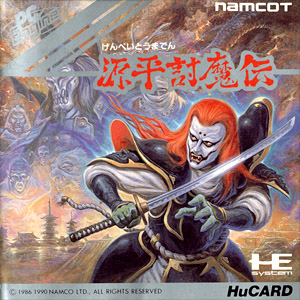
|

|
|
源平討魔伝
©1986 1990 Namco Ltd
Release : 1990-03-10 (¥6800)
HuCard (4 Mbits) NC90001
Action / Platform game
|
Genpei Tōma Den is a side scrolling action game by Namco and
conversion of the arcade game of the same name originally released in 1986. The
game tells the story of the legendary samurai warrior Taira no Kagekiyo
who has been resurrected to complete his greatest mission - ascend to the mystical
underworld, defeat his deadliest enemies and retrieve three sacred treasures. All
of this in order to defeat his arch-enemy Minamoto no Yoritomo. Unlike other
action games of its time, Genpei Tōmaden combines three different gameplay
mechanics - the Yoko mode (side-scrolling 'mini' stages), the
Big mode (side-scrolling 'large' stages) and the Heimen mode
(top-down 'plane' stages). In a nutshell, the Yoko stages feature really
small sprites and fast paced action with multiple enemies on screen, platforms, traps
and pitfalls (which lead to special penalty levels), whereas the Big stages
mainly feature bosses and large enemy battles. Finally, the plane stages are
similar to the Yoko mode, but utilize a top-down view and feature chests as
maze-like stages. Additionally, each level includes at least one red Torii gate
(traditional Japanese shrine gates) that leads to the end of the stage (or in some
occasions to a completely different location). Finally, the player comes equipped
with a lethal sword that can be upgraded by collecting purple orbs left behind by
defeated enemies - however, the sword can also lose power if Kagekiyo happens
to hit indestructible objects (such as large floating stones). Other orbs are also
available in the game, such as green orbs (they act as money),
blue orbs (health) as well as special items such as the magic scrolls
(temporary special attack) or the sword (increases power in exchange of money).
Genpei Tōma Den is a vast game and features a non-linear progression, and
many levels contain alternate hidden paths.
|
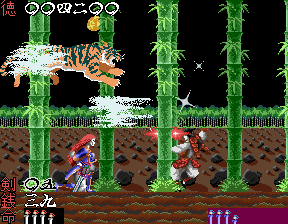 Genpei Tōma Den was an arcade game originally released by Namco in 1986
(picture on the right). The game was later converted for the Sharp X68000 (1988),
the PC Engine (1988) and was later included in the Namco Museum Vol.4 (Playstation, 1996)
where it was renamed 'The Genji and the Heike Clans' for the western releases. Interestingly,
a completely different game was released for the Famicom console in 1988 - it was a round
based boardgame/RPG based on the first Genpei Tōma Den (it also included a real
boardgame with metal figurines that could be used in association with the game). A sequel to
the original arcade game was exclusively released in 1992 for the PC Engine - this
second episode, called Genpei Tōma Den Kan no Ni
(aka Samurai Ghost in the United States), only featured the Big mode but with
new platform and trap elements.
Genpei Tōma Den was an arcade game originally released by Namco in 1986
(picture on the right). The game was later converted for the Sharp X68000 (1988),
the PC Engine (1988) and was later included in the Namco Museum Vol.4 (Playstation, 1996)
where it was renamed 'The Genji and the Heike Clans' for the western releases. Interestingly,
a completely different game was released for the Famicom console in 1988 - it was a round
based boardgame/RPG based on the first Genpei Tōma Den (it also included a real
boardgame with metal figurines that could be used in association with the game). A sequel to
the original arcade game was exclusively released in 1992 for the PC Engine - this
second episode, called Genpei Tōma Den Kan no Ni
(aka Samurai Ghost in the United States), only featured the Big mode but with
new platform and trap elements.
|
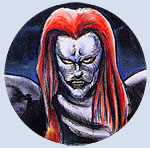 Genpei Tōma Den stars Taira no Kagekiyo, a real samurai who actually lived in
Japan in the 12th Century. He was once renowned for his unique bravery and was part
of the Taita Clan (the Heike). He later fought during the last battle of the
Genpei War, which led to the victory of the Minamoto Clan (the Genji)
and its leader, Minamoto no Yoriyomo.
Taira no Kagekiyo (picture on the left) did many cameo appearances in several Namco games, such as
Tales of Eternia (2000) and Namco × Capcom (Playstation 2, 2005), and he was
a playable character in the crossover game Namco Super Wars (WonderSawn, 2002).
Finally, Genpei Tōma Den has a strong resemblance with Getsu Fūma Den
released by Konami for the Famicom in 1987
(see Getsu Fūma Den for more information).
Genpei Tōma Den stars Taira no Kagekiyo, a real samurai who actually lived in
Japan in the 12th Century. He was once renowned for his unique bravery and was part
of the Taita Clan (the Heike). He later fought during the last battle of the
Genpei War, which led to the victory of the Minamoto Clan (the Genji)
and its leader, Minamoto no Yoriyomo.
Taira no Kagekiyo (picture on the left) did many cameo appearances in several Namco games, such as
Tales of Eternia (2000) and Namco × Capcom (Playstation 2, 2005), and he was
a playable character in the crossover game Namco Super Wars (WonderSawn, 2002).
Finally, Genpei Tōma Den has a strong resemblance with Getsu Fūma Den
released by Konami for the Famicom in 1987
(see Getsu Fūma Den for more information).
|
Game Staff (Copied from the end credits) :
|
Supervision
Jiēi Jiēi (JJ)
Takkii
|
|
Production
Yappi Asakichi
Shirukii (Silky)
Art
Haro 7000
Tākī Oharu (Turkey Oharu)
|
|
Sound
Achibin
Kagekiyoshi
Omake/Bonus
Anabō
Umi Tai-chan
|
|
G
O
O
D
I
E
S
|
|
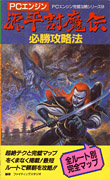
Japanese Guidebook
|
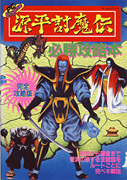
Japanese Guidebook
|
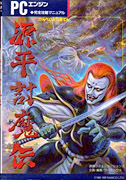
Japanese Guidebook
|
|
|
O
M
A
K
E
|
|
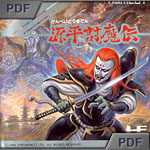

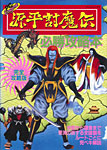
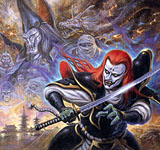
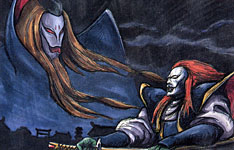
|
|
|
Click on picture to enlarge |
|
|
|
LK

|
|
Add your Pov here !
|
P
O
V
s
|
|
Genpei Tōma Den is such an oddball. While the game does show its age,
it still boasts a really unusual (and strange) character and level design that
won't leave anyone indifferent (the arcade game apparently has a sort of cult
following in Japan). The three different play modes also add some nice variation
to the game, and sprites can be fairly large on screen as well. But after the initial
premise is established, the game pretty much falls flat on its face - the controls
are clumsy and imprecise, the hit detection is shockingly poor and the difficulty
is unbalanced and unfair (you can't backtrack and continues are useless!). All in
all, despite all the good ideas that went into Genpei Tōma Den, the game
is just way too tedious to recommend.
|
|
|
|